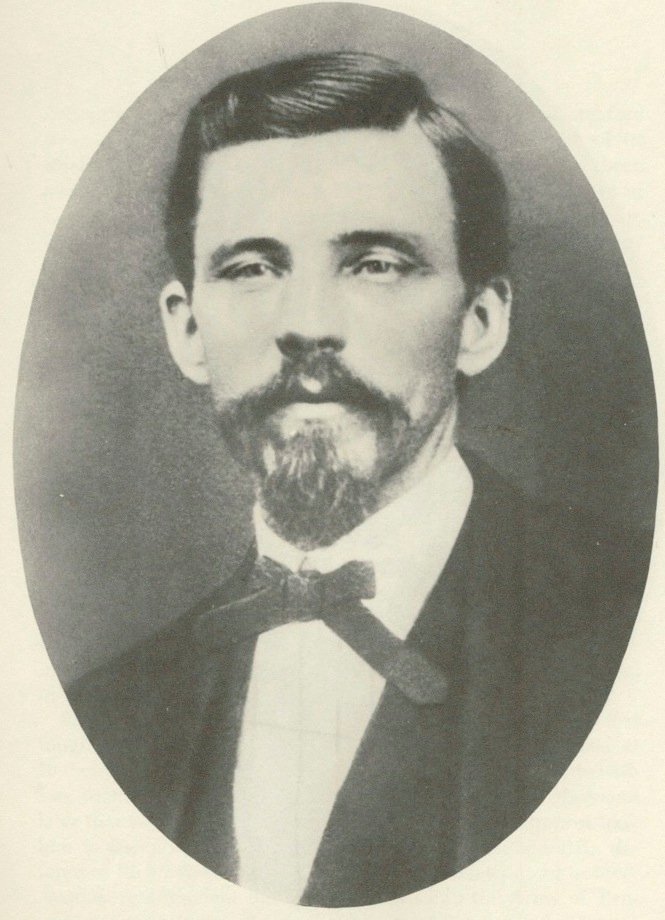
ABOVE IS A PHOTO OF JAMES WYLIE RATCHFORD
“Boys, I have done the best I could for you. Go home now. And if you make as good citizens as you have soldiers, you will do well. I shall always be proud of you. Goodbye. And God bless you all."
Robert E. Lee
April 1865
Faded and weather-beaten by more than a century of harsh sun, wind and rain, an ornately carved gravestone in the Paint Rock cemetery marks the final resting place of James Wylie Ratchford. This prominent Concho County pioneer lived an extraordinary life of seventy years, nine months and nine days leaving this world on December 3, 1910. Ratchford miraculously survived twenty-three major Civil War battles during which thousands of soldiers clad in both blue and gray gave their lives fighting for a cause they considered worthwhile. James fought in the first land battle of the war in 1861 at Big Bethel, Virginia as well as one of the last at Bentonville, North Carolina in 1865. It should also be said that seventeen other Confederate veterans rest in the Paint Rock grave yard.
James Ratchford served the Confederate States of America advancing from the rank of lieutenant to major and adjutant during his military career. Ratchford carried out duties as staff officer for three very prominent Confederate generals; Daniel Harvey Hill, John Bell Hood and Stephen D. Lee. As a staff officer for these famous Confederates, Ratchford personally delivered countless urgent dispatches and reports to Generals Robert E. Lee, Stonewall Jackson, Joseph E. Johnston, and James Longstreet as well as Confederate President Jefferson Davis. Major Ratchford knew Robert E. Lee well delivering dispatches and attending meetings with the Confederate leader. Sometimes General Lee asked the young officer for his opinion in military matters. As John Bell Hood’s adjutant Major Ratchford shared the cramped quarters of a field tent and took meals with the gallant but crippled general. Hood had lost his left arm and right leg in combat but recovered remarkably and returned to the war within months. Although Hood’s aids had to help the determined warrior into the saddle he fought on to the end of the war in spite of his terrible injuries.
After the war, James Ratchford married, started a family and moved in 1879 to west central Texas to begin a new life. In 1880, Ratchford, his wife and family arrived at Paint Rock where he took a leading role in the affairs of the newly formed Concho County. Ratchford was one of the founders of the Presbyterian Church as well as the Masonic lodge. Before the establishment of a school system in the Concho County seat, the major taught twelve students in a hastily formed private school. He received a dollar per student per month for his efforts. He served as the first Concho County clerk until 1882. Ratchford took part in surveying the boundaries of the new county. As a proud Confederate veteran Ratchford and Henry Davis Pearce founded the Concho-Colorado Confederate Veteran’s Association serving as president until his death in 1910. Henry Davis Pearce served for many years as the secretary and treasurer of the association and went on to be the first postmaster and Justice of the Peace in nearby Runnels County.
I am presently working on a manuscript titled “Where Two Rivers Meet: Little Known History of Concho, Coleman and Runnels Counties, Texas”. My research has unearthed some quite remarkable stories about this part of west central Texas. Among them are the numbers of Confederate veterans who came here after the war to begin a new life. I think these are most important accounts that very much deserve not to be brushed aside or forgotten. So much of today’s politically motivated history attempts to demonize those who fought for the cause of defending their home states and establishing a new southern nation. It is an undeniable fact that the Civil War was not fought to free the slaves and started with the election of Abraham Lincoln. These Confederate veterans, particularly those from Texas, did not go to war to preserve slavery. Most never owned slaves. They fought to defend their states, homes, values and families from a punitive federal invading army. I suggest anyone wishing to dispute this point first read Charles David Grear’s excellent book “Why Texans Fought In the Civil War”. It is published by Texas A&M University. It is well researched and documented and not driven by some modern day political agenda.
After the war, great numbers of Confederate veterans came to central and west Texas needing to start over. Many had lost everything they owned in the other southern states. Of course the Texas frontier the came to was hardly much safer that the war torn southern states. These veterans came for opportunity and cheap land. My research has shown that a great many of the first pioneering settlers of Concho, Runnels and Coleman counties had some relationship or were a family member of a Confederate veteran. Their numbers are difficult to accurately state although I think it fair to say there were probably more than 1,000 Confederate veterans associated in one way or the other in these three counties. Many of these veterans became leaders in these counties in county government, church and business. They did exactly what Robert E. Lee had hoped they would do by becoming the good citizens they proved to be.
Glenn Justice
Copyright 2015
Comments
Add Comment
Comments are not available for this entry.